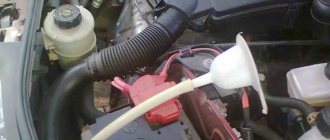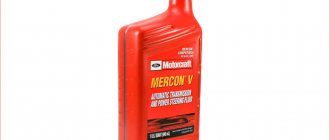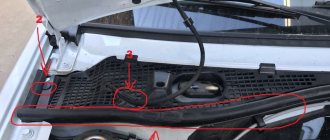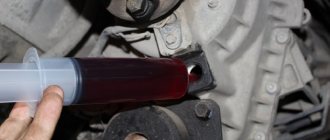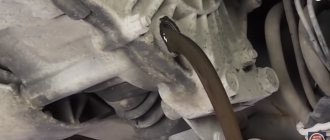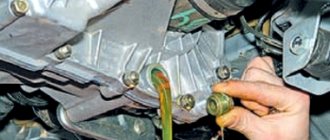The repair and operation manual for Renault Logan, Sandero, Largus, Logan 2, Sandero 2 states that the oil in the manual transmission is filled for the entire service life of the gearbox and does not require replacement. But during operation of the machine, the internal boot of the left drive often fails. The boot becomes tanned in the cold, breaks and water gets into the oil, which requires an oil change.
What kind of oil should I use?
On the assembly line, the manufacturer fills the manual transmission with Elf Tranself NFJ 75W-80, which Renault recommends for transmissions of the JXX, TL4 and NDX series.
Renault Logan, Sandero, Logan 2, Lada Largus with 1.4 liter engines were equipped with a jH1 manual transmission, while cars with 1.6 and 1.2 liter engines were equipped with a jH3. Structurally, the units differ in the size of the clutch housing, so this does not affect the choice of gear oil. Less common on cars is the JR5 manual transmission.
For topping up, use only Elf Tranself NFJ 75W-80, since mixing oils is not prohibited. For a complete replacement, it is not necessary to buy original products. You can choose among worthy analogues:
- Liqui Moly Getriebeoil 75W-80 (GL-5);
- Castrol Syntrans Transaxle 75W-90 (GL-4+);
- Motul Motylgear SAE 75W-80 (GL-5);
- Castrol Syntrans V FE 75W-80 (GL-4+);
- Shell Getriebeoil EP 75w90 (GL-4);
- Valvoline Maxlife MTF SAE 75W-80 (GL-4).
The filling volume of gearboxes jH1 and jH3 is 2.8 l, JR5 is 2.5 l. Before purchasing, we recommend that you check this information in the repair and operating manual for your car model.
Top 3. Mannol Dexron III Automatic Plus
Rating (2021): 4.80
35 reviews from resources taken into account: Yandex.Market, Ozone
Low freezing point This oil retains its fluidity down to -45 degrees, so it is excellent for northern regions.
- Characteristics
Average price: 420 rub./l
- Country: Lithuania
Universal synthetic oil for all-season use according to the specifications is perfect for Renault Logan with an automatic transmission. An oil base with a stable viscosity index and multifunctional additives ensure minimal transmission wear under intense loads in a wide temperature range. The oil remains fluid down to minus 45 degrees, so it is popular among residents of the northern regions of the country. Excellent anti-friction properties allow car owners to slightly reduce fuel consumption and increase the service life of the transmission. The fluid provides smooth gear shifting, protects against corrosion, resists aeration and prevents the formation of foam. The only drawback of this oil is the lack of a recommendation from the car manufacturer.
Advantages and disadvantages
- Stable viscosity
- Reliable automatic transmission protection
- Wide operating temperature range
- Reduces fuel consumption
- No manufacturer recommendations
Criterias of choice
When choosing transmission fluid, pay attention to the specification and viscosity. The API classification is a generally accepted classification that, through testing, determines the effectiveness of extreme pressure and anti-corrosion additives. Elf Tranself NFJ 75W-80 corresponds to the GL-4+ class, which is recommended for use in synchronized manual transmissions of passenger cars. However, it is permissible to use GL-4 and the highest class - GL-5, which is designed for loaded hypoid gears.
The SAE marking shows low-temperature (number with index W) and high-temperature characteristics. 75W formulations are recommended for regions where the temperature does not drop below -40°C. If the car is operated at temperatures not lower than -26°C, oils with an index of 80W are poured into the manual transmission. As for high-temperature characteristics, in regions with a temperate climate, a viscosity grade of 85-90 can be used.
For Renault Logan, Sandero, Logan 2, Sandero 2, Lada Largus, you can safely use oils with SAE indexes: 75W-80, 75W-90, 75W-85 and an API specification of at least GL-4.
According to the owners' experience
In reality, Renault Logan owners act differently:
- When the clutch basket was replaced, the oil was drained from the box. There was a good argument to replace the fluid completely, at the same time replacing the clutch cable, this is a disease.
- The first replacement was made after 190 thousand kilometers;
- When buying a car, the owner decided that the service interval would be 60 thousand km.
190 and 60 – these numbers differ by an order of magnitude. And both are puzzling. Regarding the first point, we note that the owner prepared for the replacement in advance: the box was warmed up, the plug was purchased immediately. We advise you to do the same.
Oil change intervals
Unlike an automatic transmission, in which ATF plays the role of a working fluid, in a manual transmission the oil serves to remove heat and reduce wear on rubbing pairs. But even in this mode of operation, irreversible chemical and physical processes occur; the oil is filled with a suspension of wear products from rubbing metal surfaces. Such negative factors reduce the life of synchronizers and gears. Therefore, it is still necessary to change the oil in manual transmissions, despite Renault service recommendations.
We recommend making the first replacement at 60 thousand km. During the first tens of thousands of kilometers of a vehicle's run, parts are worn in inside the gearbox. After the break-in period, the amount of wear products in the oil decreases, so the interval between subsequent replacements can be increased to 80-100 thousand km.
Video: Changing the oil in a manual transmission on a Renault Logan
How to check the lubricant level in a Logan manual transmission
At each routine maintenance, once every 15 thousand km, it is necessary to check the oil level of the Renault Logan manual transmission.
You will need an 8mm square wrench and a special syringe to make filling the transmission units easier.
The sequence for checking the lubricant level in a Logan manual transmission:
- Remove the engine crankcase protective shield.
- We unscrew the plug covering the filler/control hole.
- Assess the integrity of the sealing rubber washer - worn and pinched elements need to be replaced.
- The oil should touch the bottom edge or just below, but you can touch the liquid with your finger or a screwdriver.
- At a lower level, use a syringe to add lubricant to the edge of the filler hole.
- Attention! Adding lubricant through the breather hole is not allowed.
- Tighten the plug and close the crankcase with the lid.
Adviсe
- Before starting work, travel at least 10-15 km so that the oil inside the gearbox warms up and becomes less viscous.
- If the sealing gasket of the filler plug is not torn and is elastic, it can be reinstalled.
- Pay attention to the processing status. The presence of an emulsion indicates mixing of oil and water. Often such a nuisance is a consequence of a leak in the boot of the inner CV joint of the left drive shaft. Therefore, inspect the boot for tears or loose clamps. Pay attention to the transmission breather, through which, if installed incorrectly, water and dirt enter the manual transmission. Often, after unqualified repairs, craftsmen neglect the correct installation of the breather. 4.For preventive purposes, rinse and blow out the breather with compressed air. As the pressure inside the transmission increases, a completely clogged "breather" valve can push out. If the malfunction is not noticed in time, dust, dirt and moisture will render the new gear oil unusable.
5. We recommend lubricating the engine protection mounting bolts with graphite grease.
Seal
Signs of wear
It is necessary to rely only partially on mileage values, since fluid wear depends on individual driving habits and the condition of the transmission. We recommend studying the main symptoms that will tell you when to fill in new gear oil:
- the appearance of loud extraneous noise, especially when operating in neutral gear;
- Difficulty in shifting gears;
- “sluggish” operation of the switching mechanisms, which is especially noticeable in automatic transmissions;
- the appearance of vibrations or beating in the shift handle;
- the appearance of a burning smell.
All this may indicate a breakdown of any part of the assembly. However, first of all, start by changing the oil, and only then carry out detailed diagnostics.
It is important to know!
Changing the oil in the gearbox, regardless of its type, is a very important and responsible procedure. The quality and condition of the oil plays a primary role in the longevity of your gearbox. After all, just imagine how many different parts are there: gears, bearings, shafts.
All parts move at unimaginable speeds, and in order to protect them from the heat generated by friction, as well as the influence of external factors affecting the gearbox, it is important to know which gear oil will be useful. Just like the motor one, it has three types of base: mineral, semi-synthetic and synthetic.
- Mineral oil is the cheapest and most accessible oil on the market. This type of oil is added to mixtures with various additives (which contain sulfur), since in itself it is quite unstable.
- Semi-synthetics are somewhere in the middle of the price and technological category of the category between “mineral” and “synthetic”. Due to the fact that semi-synthetic oil has the thickest viscosity, it is ideal for use on cars with high mileage.
- Synthetic is a very fluid type of oil. Since its properties do not depend on external conditions (negative ambient temperature), this type of fluid does not thicken in the cold, thereby allowing all parts in the gearbox to work easier without losing performance.
Be careful!
Since different manufacturing plants produce oils, and Logan has been produced since 2005, they use different technologies, which makes the product itself varied and with different characteristics and properties. Therefore, if you want your gearbox to serve you for a long time, it is better not to experiment!
Casrtol Syntrans Transaxle 75W-90 and MOTUL GEAR 300 75 W-90
The main feature of Casrtol Syntrans Transaxle 75W-90, MOTUL GEAR 30075W-90 from a product recommended by the manufacturer is that they are one hundred percent synthetic. They have the same advantages as Tranself NFJ 75W80.
Casrtol Syntrans Transaxle 75W-90 in this case ensures more reliable operation of synchronizers when associated with classic transmission fluids that have the API GL4 standard. MOTUL GEAR 30075W-90 has long established itself as a product whose oil film remains stable even under the most severe conditions.
Their main disadvantage is their overhead. Their cost is 40-50% higher than semi-synthetics.
SourceCancel reply
You must be logged in to post a comment.
Logan.Ru portal forum
- List of forums ‹ Technical information ‹ Chassis, Transmission, Control
- Change font size
- print version
- Printable version of all messages in this topic
- Mobile view
- My mail
- Photo gallery
- Rules
- FAQ
- Registration
- Entrance
Current time: 01 Aug 2022, 23:21
Level control and required volume
If it is necessary to change or add oil in the Renault Logan gearbox, the car owner needs to know how many liters are included in the transmission. The fluid volume in a manual transmission is about 3.5 liters. The amount of lubricant in automatic transmissions is 4 liters.
Currently reading: Renault Logan engine knocking - what to do?
To check the oil level, do the following:
- Warm up the car and place it on a flat horizontal surface.
- There is no dipstick for checking the volume in Renault Logan. Diagnostics is carried out through the inspection hole, which is located in the front part of the transmission housing. There is a plastic cover in the hole; it must be wiped with a rag and unscrewed.
- You need to look into the hole. If you cannot see the oil level, you should determine it by touch by placing your finger in the hole. The amount of lubricant should be around the bottom edge.
You can learn about checking the volume from the video published by user Roni.
Logan 1.6
There is no need to add lubricant to a 4 or 5 speed transmission.
In accordance with the Renault Logan manufacturer's instructions, you only need to check its level and top up the fluid when servicing the car. However, Russian drivers constantly complain that the left boot, which is connected to the grenade and is washed with box oil, fails. That’s why the experts “pull the blanket over themselves” - they advise changing the lubricant in the gearbox every 60 km. If you don’t change it, then the gearbox may fail - you will need capital. Due to the considerable cost of both the part itself and the work, replacing the fluid as a preventative measure will definitely save you money!
An oil change in the Logan gearbox is necessary, regardless of breakdowns or high mileage. If you have a new car, you need to change the oil after using the car for six months (or after 15,000 kilometers). Usually, at the factory, the oil in the box is slightly underfilled (according to standards), and while the box is running in, its parts inside (gears) are ground in.
During this initial period of use, many particles of metal shavings enter the oil. Therefore, it is better to change it yourself, despite the service center, which will deny the obligation of this procedure. Moreover, the asking price is half an hour of time and 17 dollars!
The first step in properly changing the gearbox fluid is purchasing the right mixture. Remember that transmission mixture and motor oil are different products. And those motorists who calmly pour engine lubricant into the gearbox are at great risk. Before pouring new oil into the Renault Logan box, you need to drive a little, thereby warming up the lubricating fluid and mixing it (with dirt and impurities).
Advantages and features of ELF Tranself NFJ 75W80 oil:
- The formula used in the creation process eliminates the problem of speed jumping;
- Has heat resistance at the highest level;
- Even in the most severe frosts, it retains a liquid structure for easy gear shifting;
- EP additives for gearbox parts retain resistance to loads;
- Protection against corrosion and oxidation;
- Good viscosity stability and resistance to water.
For a safe replacement procedure, it is worth considering these examples of precautions:
- Protective gloves and a gas extraction device must be used;
- It is also necessary to use safety glasses;
- Use only serviceable tools;
- Use a hat if possible.
The list of tools used to change the oil is small:
- 8 mm square wrench.
- Pliers.
- Portable lighting.
- Wire brush.
- 10 mm socket wrench.
- Funnel with hose (0.5 m) or blower.
- Container for draining used oil.
Many people are accustomed to the mandatory change of transmission oil in manual and automatic transmissions. But, there are cars that do not need such frequent fillings, such as Logans. It is necessary to fill the Renault Logan gearbox with oil only in case of repair or complete dismantling of the mechanism.
In this case, the transmission fluid for Logan is selected very carefully in order to match the original as closely as possible. Therefore, having such a car, you need to know everything about how to pour oil into the gearbox.
If the oil seal flies on Logans, then transmission oil is automatically consumed in large quantities. It is then that changing the oil in the gearbox becomes simply necessary. Only high-quality factory oil goes into the Renault Logan box, and remember that you must control the volume so that there is no empty space.
It is better to start the replacement process when the oil is warm: after a trip. This way, the transmission fluid will flow out faster, and impurities and dirt particles will be removed better. The replacement algorithm consists of five steps.
Step 1. Find the place where the crankcase protection is located. We take a 10 mm wrench.
Step 2. Unscrew the plastic cap (pictured) by hand. The filler plug for filling the transmission fluid is unscrewed with an 8 mm wrench. Place a container before turning the key.
Step 3. Wait until the waste liquid is completely poured out. Set the container aside.
Step 4. Get out of the hole. We take new oil, pour it into the hole using a funnel and a hose. In this case, the funnel is placed in the engine compartment (pictured).
Step 5. Tighten the plug and put everything in place. Don't forget to replace the disposable gasket on the drain plug.
Semi-synthetics
- Axxis Power A LPG 10W-40;
- Azmol Leader Plus 10W-40;
- S-Oil DRAGON SL 10W-40;
- ZIC A 10W-40;
- Pennasol Super Light 10W-40.
Synthetics
- Toyota / Lexus / Daihatsu SN 5W-30;
- Pennasol Super Pace 5W-40;
- Delphi Prestige Plus 5W-40;
- Repsol Elite Multivalvulas 10W-40;
- ZIC X7 LS 10W-40.
- Axxis Power A LPG 10W-40;
- Azmol Leader Plus 10W-40;
- S-Oil DRAGON SL 10W-40;
- Pennasol Super Light 10W-40;
- ZIC A 10W-40.
Synthetics
- Toyota / Lexus / Daihatsu SN 5W-30;
- Pennasol Super Pace 5W-40;
- Repsol Elite Multivalvulas 10W-40;
- Delphi Prestige Plus 5W-40;
- ZIC X7 LS 10W-40.
Semi-synthetics
- Axxis Power A LPG 10W-40;
- Azmol Leader Plus 10W-40;
- Pennasol Super Light 10W-40;
- ZIC A 10W-40;
- Axxis Power X 10W-40.
Synthetics
- Toyota / Lexus / Daihatsu SN 5W-30;
- Pennasol Super Pace 5W-40;
- Repsol Elite Multivalvulas 10W-40;
- ZIC X7 Diesel 10W-40;
- ZIC X7 LS 10W-40;
- Axxis Gold Sint A3/B4 5W-40.
- Warm up the engine to operating temperature and then let it cool for 5-7 minutes. The oil drains better and faster if it is not cold. Hot temperatures can burn you, so it’s better to let the engine sit for a while.
- Open the filler neck of the cylinder block (where we will pour oil) and pull out the dipstick. If you give oxygen through, the liquid will flow out faster.
- We jack up the car and put it on supports. A necessary step for easy access to the drain plug. You can also use a viewing hole or overpass.
- Unscrew the drain plug with a wrench. Remember that used oil will be hot and take precautions to avoid skin burns.
- We pour the waste into the prepared container. Do not dump waste directly onto the ground!
- Unscrew the oil filter. If the filter is tightly clamped, a special removable filter wrench may be required.
- We install the new filter after lubricating its sealing ring with oil, and pouring a little oil right into the middle so that it absorbs. The number of the original oil filter is 8200768913. Cheaper analogues that are suitable for Logan: FRAM PH5796, MANN W753, MAHLE C467, FILTRON P6433, PURFLUX LS932 and many others.
- We tighten the drain plug after making sure that the washer located on its thread is intact. If necessary, it must be replaced (sealing washer).
- We lower the car from the racks and pour oil into the empty engine, guided by the dipstick.
- After the poured oil reaches the middle of the dipstick between the MIN and MAX marks, wait 3-5 minutes. Afterwards we warm up the engine for about 5 minutes and measure the level again. As a rule, after the first warm-up the level drops and we add as much as we need.
Currently reading: Buy auto parts Logan clutch for foreign cars in the online store AUTOPITER
To replace the power steering fluid, remove the air duct and the reservoir with power steering fluid. Pour the old liquid from the barrel into another container. When draining, pay attention to the condition of the old oil and the presence of foreign metal particles.
If they are noticeable, this may indicate wear on the pump. To completely drain the power steering, you can rotate the steering wheel left and right.
Replacing the sensor does not require much effort. At the rear of the cylinder block (where the unit number is indicated), press the wire lock and remove the terminal. The sensor itself is unscrewed with a key x 22. When installing a new sensor, make sure that there is a sealing washer.
This is done during an oil change, at approximately 15 thousand kilometers (officials call this figure). If you change the oil at 10 thousand, then it is better to change the filter to a new one.
For motor 1.4/1. 6 eight-valve engines will require 3.3 synthetic or semi-synthetic oil.
For a sixteen-valve 1.6 you need to pour 4.9 liters. Don't forget to make a reserve of ~0.5/1 l.
for periodic monitoring of engine oil level. The Logan gearbox (box) needs to be filled with 3.1 liters of gear oil (applies to 1.4 and 1.
6). The automatic transmission (automatic transmission) is more voracious and will ask for 7.6 liters.
The hydraulic booster and brake system will require 1 liter (1 liter for each system). The cooling system will ask you to fill it with 5.45 liters.
Oil drained from the gearbox at 60 thousand km. It was already very dirty, so the checkpoint was working with problems
However, despite the fact that the manufacturer (by the way, the plant was built in 2003) did not set a time limit for changing transmission oil and fluids, explaining that this is not required for the correct and smooth operation of the gearbox, experienced craftsmen and service center mechanics for servicing Renault cars, they recommend replacement every 60,000-100,000 kilometers (depending on conditions and operating time).
Find out more about when it is necessary to change the oil on a Renault Logan here!
And on the other hand, no one is immune from the fact that before this cherished mileage occurs, the clutch will fail or the CV joint on the left side will not need to be replaced, and then changing the oil in the gearbox becomes a desirable procedure. To avoid premature failure, monitor the condition of the CV joint boots and change them if they are damaged!
